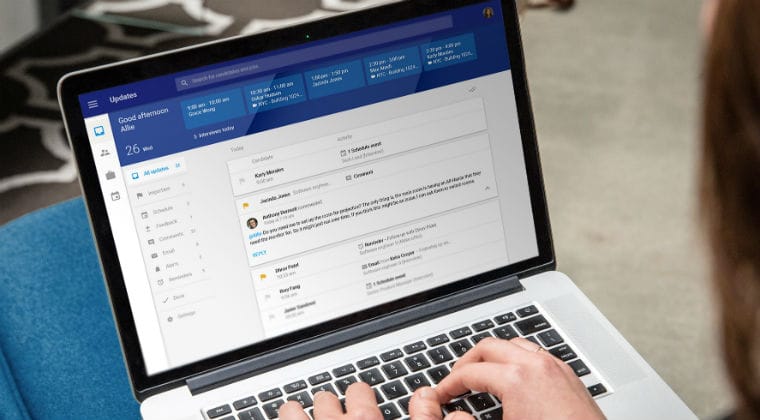While human resources used to be a more functional role, over the years it has become more strategic, with more HR executives earning a seat at the table. On the front lines, HR managers also have an evolved job description, increasingly relying on technology to take over the automatable parts of their job so that they can focus on more human tasks.
Just as employees are expected to grow with the times and learn technology skills like data science and programming that make them more attractive to employers and relevant to the jobs of the future, HR managers must do the same.
Technology is gaining a larger role in many traditional HR duties, from recruiting to scheduling to performance management. This has been happening for a while and means that HR managers must be prepared to learn new systems and skills related to the software an organization uses. Relying on current skills is not going to get an HR manager far. They must be willing to be flexible, show curiosity and learn new skills.
Also read: HR 101 for new human resources managers
However, if an HR manager is tech-savvy enough to manage various HR technology systems, ultimately they will have more time to focus on the HR duties that require timeless skills like tact and empathy.
Programs enabled with artificial intelligence, for example, can help answer common employee and candidate questions, leaving HR professionals time to focus on other responsibilities rather than repeatedly answer the same common, basic questions. Chatbots can’t answer more complex questions, but they can alert a person to answer those queries.

In the recruiting context, technology can help HR managers quickly review resumes. This has both advantages and risks. On one hand, employers don’t spend as much time going over resumes. On the other hand, recruiting technology may make biased decisions if it has been programmed with biased training data. Still, with appropriate training data, this has potential to make the recruiting process better.
Also read: How the talent acquisition game has changed in the past decade
And with scheduling, workforce management software can help HR managers create schedules, even considering compliance laws that make scheduling complicated. Different states and localities have varied regulations regarding paid time off, sick leave and overtime. But the appropriate software can take regulations into account as someone creates a schedule for its workforce.
Meanwhile, some HR tasks should always retain the human touch. Managers should always terminate employees face to-face, avoiding doing so via text message, email or other forms of virtual communication. Managers also have key communications responsibilities — for those times as common as the annual open enrollment and as unique as a crisis or global pandemic. Being able to effectively, strategically and sympathetically communicate information is part of the HR job description that does not change with the advance of HR technology solutions.
Given these tech-enabled and human-centric HR tasks, when a company is looking for a new HR manager, employers should include certain responsibilities in their job description. Some of these skills are constant:
- Consults legal counsel to ensure that policies comply with federal and state law.
- Develops and maintains a human resources system that meets top management information needs.
- Oversees the analysis, maintenance and communication of records required by law or local governing bodies, or other departments in the organization.
- Advises management in appropriate resolution of employee relations issues.
Other responsibilities can likely be streamlined through technology:
- Recruits, interviews, tests and selects employees to fill vacant positions.
- Responds to inquiries regarding policies, procedures and programs.
- Administers benefits programs such as life, health and dental insurance, pension plans, vacation, sick leave, leave of absence and employee assistance.
- Prepares budget of human resources operations.
- Responds to inquiries regarding policies, procedures, and programs.
Additionally, the rise of technology solutions adds extra responsibilities to that list, like understanding how to use several types of tech tools. These include:
- Knowing how to use social media to post jobs, research candidates and communicate with employees.
- Knowing how to use an applicant tracking system.
- Using talent management software and learning management systems can help you streamline hiring, onboarding, training and retention processes.
- Using time and attendance software to quickly and efficiently create compliant, fair schedules.
While HR practitioners are expected to do more than ever before, they have more technology and tools available to make their jobs more efficient in many ways.






 Equity derivatives clearing organization OCC named
Equity derivatives clearing organization OCC named  U.S.-headquartered
U.S.-headquartered  Health care technology company
Health care technology company  Mobile commerce optimization platform Button named Ken Stelzer as chief financial officer. Stelzer will build a strategic finance function at Button to accelerate revenue and profit growth. He brings nearly 20 years of experience in finance and operations at both public and private companies. Most recently, he was the chief financial officer of Zocdoc. Before that he served as CFO of Bankrate and Integreon. He has significant expertise in corporate finance, executing growth initiatives and implementing operational efficiencies to drive profitability. He’s also overseen M&A transactions valued at more than $6 billion and helped raise more than $4 billion in capital through debt and equity offerings.
Mobile commerce optimization platform Button named Ken Stelzer as chief financial officer. Stelzer will build a strategic finance function at Button to accelerate revenue and profit growth. He brings nearly 20 years of experience in finance and operations at both public and private companies. Most recently, he was the chief financial officer of Zocdoc. Before that he served as CFO of Bankrate and Integreon. He has significant expertise in corporate finance, executing growth initiatives and implementing operational efficiencies to drive profitability. He’s also overseen M&A transactions valued at more than $6 billion and helped raise more than $4 billion in capital through debt and equity offerings. Button also named Stephanie Mardell as chief people officer. Mardell will continue evolving Button into a place of admirable talent. She was previously vice president of people at Button. As the company’s 14th employee, she built its people team from scratch through her meticulous, data-driven approach to people operations, garnering Button recognition as one of the best places to work year over year by
Button also named Stephanie Mardell as chief people officer. Mardell will continue evolving Button into a place of admirable talent. She was previously vice president of people at Button. As the company’s 14th employee, she built its people team from scratch through her meticulous, data-driven approach to people operations, garnering Button recognition as one of the best places to work year over year by  Eightfold.ai also named Celia Poon as chief financial officer. A seasoned finance executive with experience in both public and private fast-growing companies in Silicon Valley, Poon joins Eightfold.ai following a year in which the company opened two new international offices and reached over $55 million in total funding. Poon will lead all financial operations with a focus on building out financial functions. Poon brings broad finance leadership experience to Eightfold.ai, having served as chief financial officer at both Wag Labs Inc. and Highfive. Prior to her roles as CFO, Poon served as VP of finance at Twitter for four years as well as VP of corporate finance at Zynga, and VP of corporate finance and treasury at Yahoo. Poon graduated with an economics degree from the University of California, Los Angeles, and holds MBA degree from the Walter A. Haas School of Business at the University of California, Berkeley.
Eightfold.ai also named Celia Poon as chief financial officer. A seasoned finance executive with experience in both public and private fast-growing companies in Silicon Valley, Poon joins Eightfold.ai following a year in which the company opened two new international offices and reached over $55 million in total funding. Poon will lead all financial operations with a focus on building out financial functions. Poon brings broad finance leadership experience to Eightfold.ai, having served as chief financial officer at both Wag Labs Inc. and Highfive. Prior to her roles as CFO, Poon served as VP of finance at Twitter for four years as well as VP of corporate finance at Zynga, and VP of corporate finance and treasury at Yahoo. Poon graduated with an economics degree from the University of California, Los Angeles, and holds MBA degree from the Walter A. Haas School of Business at the University of California, Berkeley.  Recruitment marketing company
Recruitment marketing company 





 Considering this is a merger of like organizations, the dreaded “duplication of efforts” specter hangs heavy. Are layoffs, buyouts, rightsizing or downsizing in the future of this new marriage? During this honeymoon period they are saying all the right things, noting that the combined organization will have 12,000 total employees “
Considering this is a merger of like organizations, the dreaded “duplication of efforts” specter hangs heavy. Are layoffs, buyouts, rightsizing or downsizing in the future of this new marriage? During this honeymoon period they are saying all the right things, noting that the combined organization will have 12,000 total employees “ That could very well be the case. With the meshing of cultures, perhaps no department or staff member will be downsized. Maybe they’ll reskill portions of their workforce.
That could very well be the case. With the meshing of cultures, perhaps no department or staff member will be downsized. Maybe they’ll reskill portions of their workforce.

